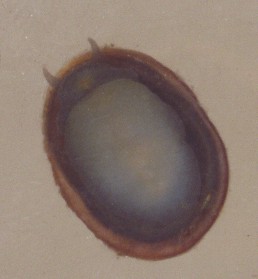|
Freshwater Molluscan Shells: Limpets
families [Physidae] [Lymnaeidae] [Chilinidae] [Planorbidae]
Freshwater limpets are small to minute and, like freshwater mollusks in general, polyphyletic. None are related to marine limpets. In freshwater mollusks, a limpet-like form has arisen multiple times from more than one lineage of coiled aquatic pulmonate snails, but from pulmonates alone. Somewhat similar forms from the family Latiidae (also pulmonate) and the non-related Neritidae lack the centralized apex. The Lancinae are confined to the Pacific drainages of North America while the Acroloxidae have an extremely disjunct distribution, several widely separated localities scattered over the northern hemisphere. They share a dextral organization of soft anatomy which is reflected in the assymetry of their shells. "Ancylidae" (taxomomic groups within the Planorbidae) have a sinistral organization, and a corresponding sinistral assymetry in the shell, and a near worldwide distribution.
Burch, (1982) uses the following classification for North American freshwater limpets:
Order Superfamily Family Subfamily Genus Acroloxoidea Acroloxidae Acroloxus Limnophila Lymnaeoidea Lymnaeidae Lancinae Fisherola
Lanx, with subgenera
Lanx ss, and WalkerolaAncyloidea
(superfamily also
includes families
Physidae, Planorbidae)Ancylidae
Ancylinae
Ferrissinae
LaevapecinaeRhodacmaea
Ferrissia
Hebetancylus
Laevapex
Banarescu's more conservative approach uses:
Superfamily Family Subfamily Tribe genus Acroloxidae Acroloxus
PseudancylastrumLymnaeidae Lancinae Fisherola
Lanx, with subgenera
Lanx ss, and WalkerolaLymnaeacea Planorbinae Ancylini Ancylus Planorbidae Bulininae
Physastrini
BulininiFerrissia
Pettancylus
Patelloplanorbis
Ancylastrum
LaevapexRhodacmeinae Rhodacmaea
A few examples, all magnified:

Lanx subrotundata (Tryon, 1856) At 10 mm, relatively large for a freshwater limpet. Living
animal, (8x) and shells, 4x. From a river in Oregon flowing over bedrock. When in habitat, each
animal has a small tuft of algae fibers on the shell, though none was growing on other objects or
surfaces.
Ancylus fluviatilis (Muller, 1774) 8x.
European lakes. Interior and side view,
apex on upper right.
Ferrissia tasmanica
(Tenison Woods, 1876)
New South Wales, Australia.
8x magnification.
Ferrissia rivularis (Say, 1817)
Most of North America.
8x magnification.
Laevapex fuscus (Adams, 1841) Much of North
America, lower elevations. Dark surface encrustations
are typical. 8x magnification.
Ancylus sp. Southwestern Brazil, rivers. Right
image shows the inside surface of this
translucent shell. 8x magnification.
Pilsbry and Becquaert, (1927) use the following classification for African freshwater limpets. They include 22 species in the genus Barnupia, endemic to Africa. Several of their nominal genera were not included in Banarescu's accounting.
Ancylidae
........."Ancylus"
.....Ferrissiinae
........Ferrissia
........Kincaidilla
........Barnupia
.....Pseudancylinae
........Pseudancylus
Barnupia kimiloloensis Pilsbry
and Becquaert, 1927. Kimilolo
River, Africa. 6 mm. Courtesy
American Museum of Natural History.
families [Physidae] [Lymnaeidae] [Chilinidae] [Planorbidae]
[Home Page] [Site Map]